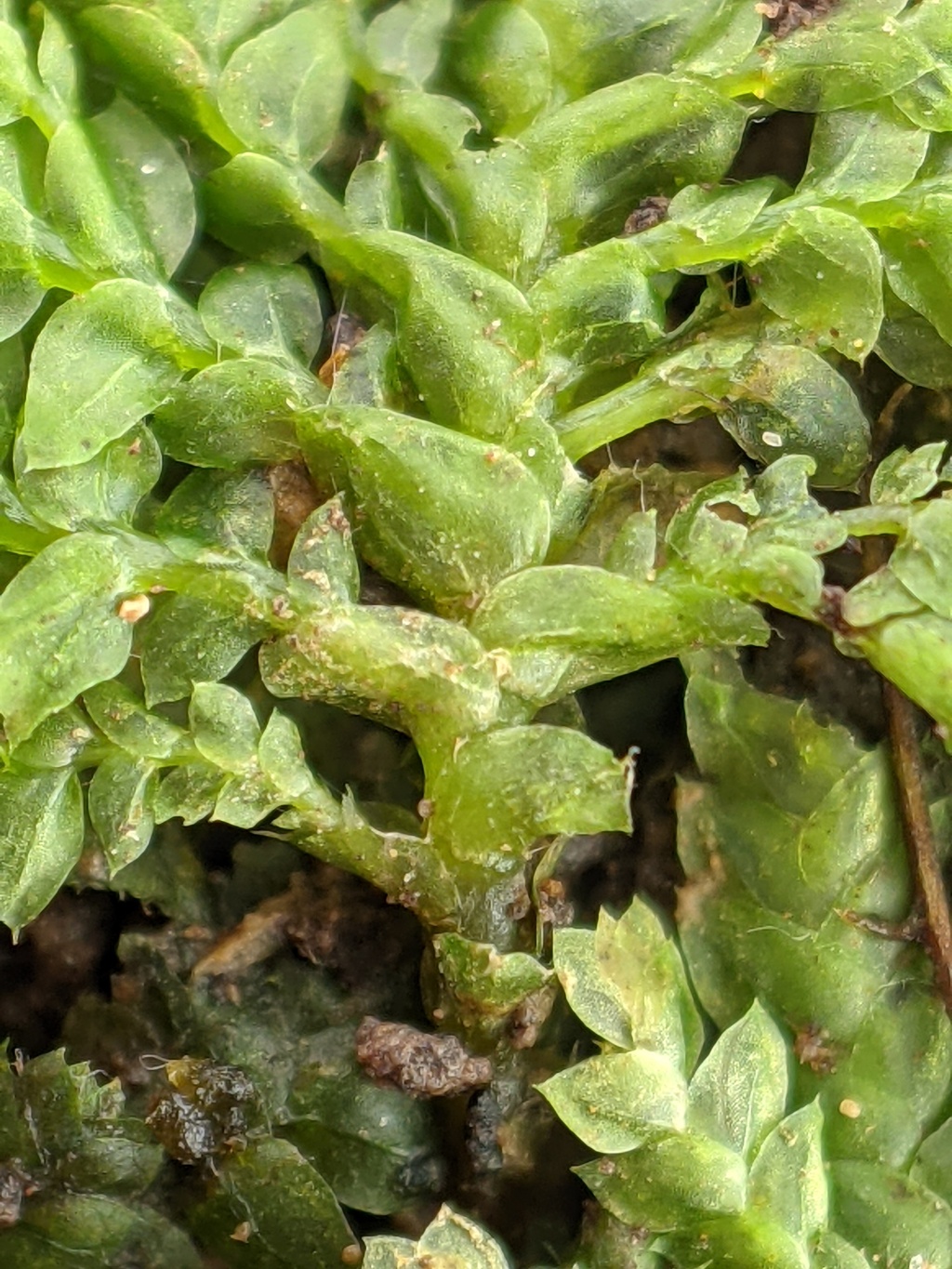Hypopterygium tamarisci
(Sw.) Brid. ex Müll.Hal.Monoicous, dioicous or heteroicous. Asexual reproduction by filamentous gemmae borne on stems toward apices or caducous branches. Densely gregarious to isolated stems arising from rocks, tree ferns or tree trunks or less often logs or soil, up to 7 cm tall. Stems with an unbranched stipe section for up to 3.4 cm from base, erect from substrate, bending so that highly branched, frondose section is ±parallel with substrate or not bent and continuing in same direction as stipe, tomentose in stipe section at base or throughout; central strand present. Frond pinnately to tripinnately branched, palmate or umbellate. Leaves flat to concave abaxially, complanate throughout frond, usually isomorphic in stipe and base of rachis, otherwise dimorphic, in 3 ranks throughout frond, with a distinct or faint, sometimes interrupted border of more elongate cells 1–5 cells wide; laminal cells away from margins hexagonal, 15–60 μm long, 10–25 μm wide. Stipe and basal rachis leaves appressed to squarrose-recurved, symmetric or asymmetric, broadly ovate to triangular, ovate, elliptic or short-ligulate, 0.3–1.5 mm long, 0.2–1.5 mm wide; apex acute or acuminate; costa faint to distinct, extending (1/5–) 1/2–4/5 of leaf length; margin entire or weakly serrate, frequently partly or entirely recurved. Lateral frond leaves incubous, asymmetric, ovate, 0.7–2 mm long, 0.3–1.5 mm wide; apex acuminate; costa faint to distinct, extending 1/3–4/5 of leaf length; margin entire to coarsely serrate. Ventral frond leaves symmetric, orbicular to elliptic or ovate, 0.1–1.7 mm long, 0.1–2.5 mm wide; apex acuminate; costa faint to distinct, extending at least 1/4 of leaf length, often percurrent or excurrent; margin entire to coarsely serrate. Setae 6–25 mm long, light yellowish-brown to reddish-brown. Capsule globose to ellipsoid, horizontal to pendent, 0.5–2.3 mm long. Operculum short- to long-rostrate, 0.7–2.2 mm long.
GleP, VVP, GipP, WaP, CVU, GGr, EGL, EGU, HSF, HNF, OtR, Strz. Pantropical to temperate regions of the southern hemisphere. Widespread south of the Great Dividing Range with occasional records along the Great Dividing Range (e.g. the Grampians) in wet sclerophyll forest, usually close to streams in fern gullies, or in rainforest.
Hypopterygium tamarisci is variable in several features including the prevalence of gemmae and other asexual propagules, sexuality, growth form and costa length, and extreme forms have been recognised as separate species (i.e. H. debile Reichardt, H. laricinum (Hook.) Brid., H. muelleri Hampe and H. tenellum Mull. Hal.). Plants of intermediate morphology between these forms obscure clear morphological distinctions and chloroplast trnL-trnF sequence divergence between extreme forms was minor and within the level of variation typically observed in other moss species (Pfeiffer et al. 2000). Consequently, these forms are better included within a single variable H. tamarisci (Pfeiffer et al. 2000).
The name H. rotulatum (Hedw.) Brid. has been applied to both H. didictyon and H. tamarisci in Australia (Scott & Stone 1976). Features that allow differentiation between Hypopteryium species are not included in the original description and illustration lectotype of H. rotulatum and as a result it is impossible to determine which species this name applies to. Consequently, H. rotulatum should be regarded as a nomen ambiguum.
 Spinning
SpinningKruijer, H. (2002). Hypopterygiaceae of the world. Blumea supplement 13: 1–388.
Kruijer, H. (2006). Hypopterygiaceae, in McCarthy, P.M. (ed.), Flora of Australia, vol. 51, pp. 377–388.. ABRS and CSIRO, Canberra and Melbourne.
Pfeiffer, T.; Kruijer, J.D.; Frey, W.; Stech, M. (2000). Systematics of the Hypopterygium tamarisci complex (Hypopterygiaceae, Bryopsida): implications of molecular and morphological data. Studies in austral temperate rain forest bryophytes 9. Journal of the Hattori Botanical Laboratory 89: 55–70.
Scott, G.A.M.; Stone, I.G. (1976). The mosses of Southern Australia. Academic Press, London, New York, San Francisco.

